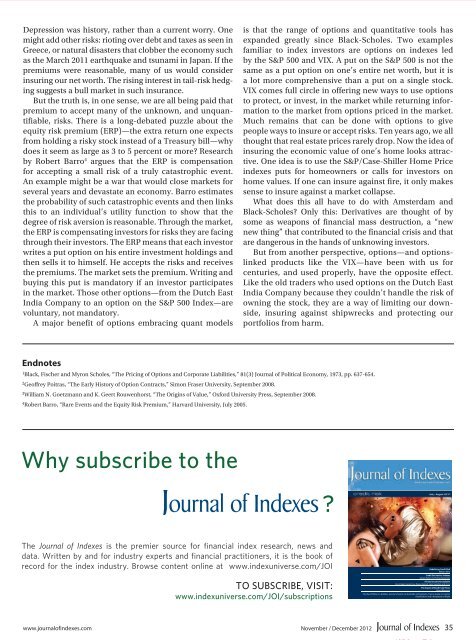Download complete issue - IndexUniverse.com
Download complete issue - IndexUniverse.com
Download complete issue - IndexUniverse.com
You also want an ePaper? Increase the reach of your titles
YUMPU automatically turns print PDFs into web optimized ePapers that Google loves.
Depression was history, rather than a current worry. One<br />
might add other risks: rioting over debt and taxes as seen in<br />
Greece, or natural disasters that clobber the economy such<br />
as the March 2011 earthquake and tsunami in Japan. If the<br />
premiums were reasonable, many of us would consider<br />
insuring our net worth. The rising interest in tail-risk hedging<br />
suggests a bull market in such insurance.<br />
But the truth is, in one sense, we are all being paid that<br />
premium to accept many of the unknown, and unquantifiable,<br />
risks. There is a long-debated puzzle about the<br />
equity risk premium (ERP)—the extra return one expects<br />
from holding a risky stock instead of a Treasury bill—why<br />
does it seem as large as 3 to 5 percent or more? Research<br />
by Robert Barro 4 argues that the ERP is <strong>com</strong>pensation<br />
for accepting a small risk of a truly catastrophic event.<br />
An example might be a war that would close markets for<br />
several years and devastate an economy. Barro estimates<br />
the probability of such catastrophic events and then links<br />
this to an individual’s utility function to show that the<br />
degree of risk aversion is reasonable. Through the market,<br />
the ERP is <strong>com</strong>pensating investors for risks they are facing<br />
through their investors. The ERP means that each investor<br />
writes a put option on his entire investment holdings and<br />
then sells it to himself. He accepts the risks and receives<br />
the premiums. The market sets the premium. Writing and<br />
buying this put is mandatory if an investor participates<br />
in the market. Those other options—from the Dutch East<br />
India Company to an option on the S&P 500 Index—are<br />
voluntary, not mandatory.<br />
A major benefit of options embracing quant models<br />
is that the range of options and quantitative tools has<br />
expanded greatly since Black-Scholes. Two examples<br />
familiar to index investors are options on indexes led<br />
by the S&P 500 and VIX. A put on the S&P 500 is not the<br />
same as a put option on one’s entire net worth, but it is<br />
a lot more <strong>com</strong>prehensive than a put on a single stock.<br />
VIX <strong>com</strong>es full circle in offering new ways to use options<br />
to protect, or invest, in the market while returning information<br />
to the market from options priced in the market.<br />
Much remains that can be done with options to give<br />
people ways to insure or accept risks. Ten years ago, we all<br />
thought that real estate prices rarely drop. Now the idea of<br />
insuring the economic value of one’s home looks attractive.<br />
One idea is to use the S&P/Case-Shiller Home Price<br />
indexes puts for homeowners or calls for investors on<br />
home values. If one can insure against fire, it only makes<br />
sense to insure against a market collapse.<br />
What does this all have to do with Amsterdam and<br />
Black-Scholes? Only this: Derivatives are thought of by<br />
some as weapons of financial mass destruction, a “new<br />
new thing” that contributed to the financial crisis and that<br />
are dangerous in the hands of unknowing investors.<br />
But from another perspective, options—and optionslinked<br />
products like the VIX—have been with us for<br />
centuries, and used properly, have the opposite effect.<br />
Like the old traders who used options on the Dutch East<br />
India Company because they couldn’t handle the risk of<br />
owning the stock, they are a way of limiting our downside,<br />
insuring against shipwrecks and protecting our<br />
portfolios from harm.<br />
Endnotes<br />
1 Black, Fischer and Myron Scholes, “The Pricing of Options and Corporate Liabilities,” 81(3) Journal of Political Economy, 1973, pp. 637-654.<br />
2 Geoffrey Poitras, “The Early History of Option Contracts,” Simon Fraser University, September 2008.<br />
3 William N. Goetzmann and K. Geert Rouwenhorst, “The Origins of Value,” Oxford University Press, September 2008.<br />
4 Robert Barro, “Rare Events and the Equity Risk Premium,” Harvard University, July 2005.<br />
Why subscribe to the<br />
The Journal of Indexes is the premier source for financial index research, news and<br />
data. Written by and for industry experts and financial practitioners, it is the book of<br />
record for the index industry. Browse content online at www.indexuniverse.<strong>com</strong>/JOI<br />
TO SUBSCRIBE, VISIT:<br />
www.indexuniverse.<strong>com</strong>/JOI/subscriptions<br />
Redefining Credit Risk<br />
William Mast<br />
Credit Derivatives Indexes<br />
Gavan Nolan and Tobias Sproehnle<br />
A Fixed-In<strong>com</strong>e Roundtable<br />
Ken Volpert, Jason Hsu, Waqas Samad, Larry Swedroe and more<br />
The Impact of Bond Fund Flows<br />
David Blanchett<br />
Plus David Blitzer on bubbles, Jeremy Schwartz on dividends and buybacks, Francis Gupta on country<br />
classifications and a biography on Bogle<br />
www.journalofindexes.<strong>com</strong> November / December 2012 35

















